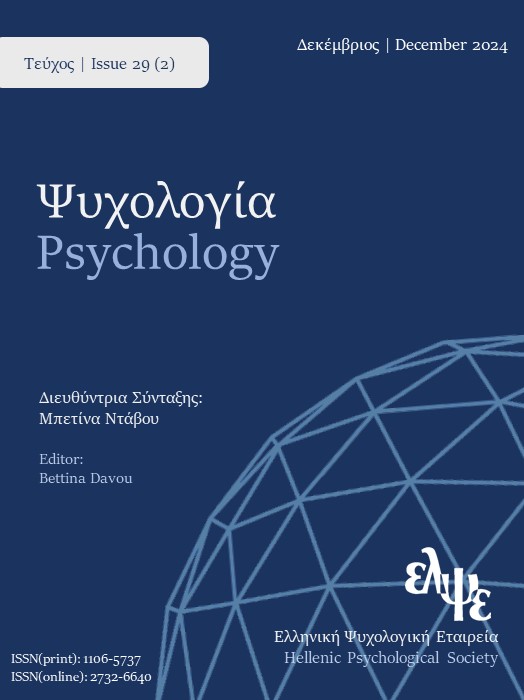Μετάφραση και ψυχομετρική αξιολόγηση της ελληνικής εκδοχής της Κλίμακας ντροπής και ενοχής για την εικόνα σώματος (Body Image Guilt and Shame Scale)

Περίληψη
Αυτή η μελέτη εξέτασε τις ψυχομετρικές ιδιότητες της ελληνικής εκδοχής του Body Image Guilt and Shame Scale (BIGSS) σε δείγμα γενικού πληθυσμού (N = 2867) και των δύο φύλων. Χρησιμοποιήθηκε σύνθετο ερωτηματολόγιο αποτελούμενο από δημογραφικές πληροφορίες, στοιχεία για το βάρος, το ύψος και το Δείκτη Μάζας Σώματος και από τα ερωτηματολόγια Body Image Guilt and Shame Scale (BIGSS), Body Appreciation Scale, Other as Shamer και Experience of Shame Scale. Σύμφωνα με τη βέλτιστη παραγοντική δομή (η οποία προέκυψε από τη διερευνητική ανάλυση παραγόντων) το BIGSS αποτελείται από δύο παράγοντες, όπως και στην πρωτότυπη στάθμιση. Αυτοί οι δύο παράγοντες αντικατοπτρίζουν την ενοχή για την εικόνα σώματος και την ντροπή για την εικόνα σώματος. Προέκυψε ένας ακόμη παράγοντας, ο οποίος δεν αντιστοιχεί σε ενοχή και ντροπή για την εικόνα του σώματος και οι προτάσεις του χρησιμεύουν ως συμπληρωματικες στα 15 σενάρια του BIGSS. Η τιμή α του Cronbach ήταν 0,90 για την υποκλίμακα Body Image Shame και το 0,85 για την υποκλίμακα Body Image Guilt. Υπήρξε σημαντική θετική συσχέτιση των υποκλιμάκων Body Image Guilt και Body Image Shame με το Other as Shamer και το Experience of Shame Scale και αρνητική με το Body Appreciation Scale. Το φύλο και ο Δείκτης Μάζας Σώματος προέβλεπαν σημαντικά τη βαθμολογία στις υποκλίμακες Body Image Guilt και Body Image Shame και η ηλικία στην υποκλίμακα Body Image Guilt. Συμπερασματικά, η ελληνική εκδοχή του BIGSS έχει ικανοποιητική εγκυρότητα και αξιοπιστία εσωτερικής συνέπειας και είναι κατάλληλη για ερευνητικές χρήσεις και για κλινικές εφαρμογές.
Λεπτομέρειες άρθρου
- Πώς να δημιουργήσετε Αναφορές
-
Τόγκας Κ., & Αλεξιάς Γ. (2022). Μετάφραση και ψυχομετρική αξιολόγηση της ελληνικής εκδοχής της Κλίμακας ντροπής και ενοχής για την εικόνα σώματος (Body Image Guilt and Shame Scale). Ψυχολογία: το περιοδικό της Ελληνικής Ψυχολογικής Εταιρείας, 27(1), 194–209. https://doi.org/10.12681/psyhps.25900
- Ενότητα
- ΕΜΠΕΙΡΙΚΕΣ ΕΡΓΑΣΙΕΣ

Αυτή η εργασία είναι αδειοδοτημένη υπό το Creative Commons Attribution-ShareAlike 4.0 International License.
Το περιοδικό ΨΥΧΟΛΟΓΙΑ έχει υιοθετήσει μία πολιτική Platinum open-access. Τα έξοδα υποβολής, επεξεργασίας ή δημοσίευσης των εργασιών καλύπτονται από την Ελληνική Ψυχολογική Εταιρεία. Τα πνευματικά δικαιώματα των δημοσιευμένων εργασιών προστατεύονται από την άδεια 'Creative Commons Attribution-ShareAlike 4.0 International'. Οι Συγγραφείς διατηρούν τα Πνευματικά Δικαιώματα και χορηγούν στο περιοδικό το δικαίωμα της πρώτης δημοσίευσης. Η άδεια αυτή επιτρέπει σε τρίτους, να χρησιμοποιούν την εργασία σε οποιαδήποτε μορφή, με την προϋπόθεση της διατήρησης των διατυπώσεων που προβλέπονται στην άδεια σχετικά με την αναφορά στον αρχικό δημιουργό και την αρχική δημοσίευση στο περιοδικό ΨΥΧΟΛΟΓΙΑ. Επιπλέον, κάθε διανομή της εργασίας οφείλει να γίνεται με τους ίδιους όρους διανομής, δηλαδή με την ίδια άδεια Creative Commons.




